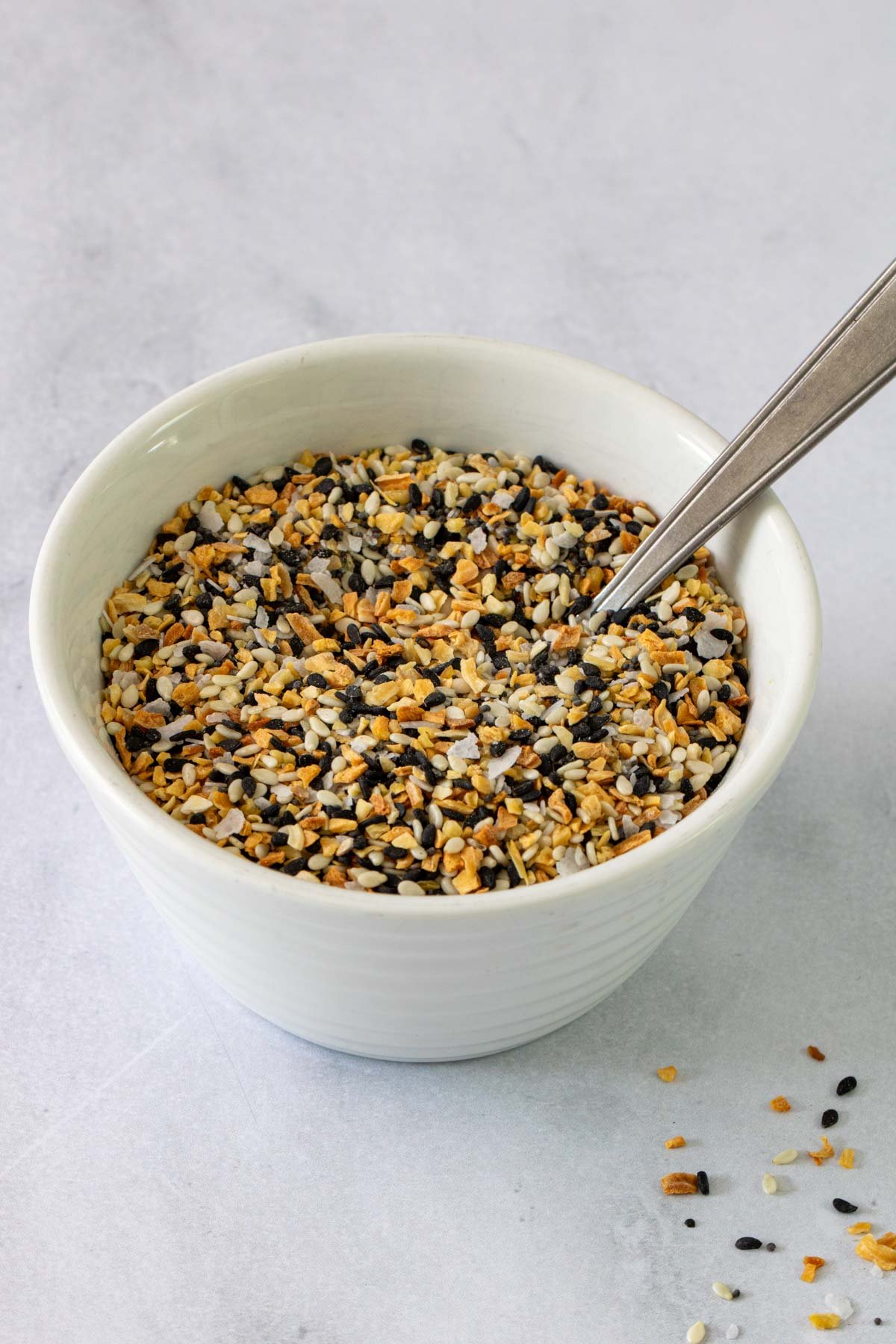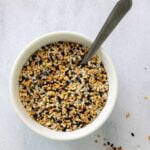Covered in a zesty lemon vinaigrette and filled with veggies and feta cheese, this lentil and quinoa salad is a fresh and flavorful salad recipe that is packed full of fiber and vegetarian protein.

I’ve said it before and I’ll say it again, I love hearty grain and legume salads. Not only are they easy and inexpensive to make, but they keep well in the fridge for days, which makes them perfect for meal prep. You can whip them up on the weekend, store them in the fridge, and enjoy them for simple meals and side dishes for days to come.
This lentil quinoa salad is a tabouli-style salad that is inspired by the Costco quinoa salad and it’s super simple to make. Made with pantry and kitchen staples, this is a versatile salad recipe that you can adapt based on whatever seasonal veggies you have on hand. I think it’s the perfect summer side dish for everything from a light lunch to a family BBQ.

Why You’ll Love It
- Quick and Easy – Ready in 30 minutes, this quinoa lentil salad is really quick to make.
- High in Fiber – With over 4 grams of fiber per serving, this salad is a fiber-packed meal.
- Keeps Well – This salad keeps well in the fridge for up to 5 days making it a great make-ahead meal for meal prep.

Ingredients + Substitutions
- Lentils – To add some complex carbohydrates, plant-based protein, and fiber. I used brown lentils, but green lentils will also work, red lentils are not recommended. The recipe calls for raw lentils, but you can use canned lentils if preferred, see the notes section of the recipe card for details.
- Quinoa – To add more complex carbohydrates, plant-based protein, and fiber. I used tricolor quinoa, but white or red quinoa will also work well.
- Veggies – To add more fiber and micronutrients. I used a combination of red onion, bell peppers, tomatoes, and cucumber, but carrots and finely chopped broccoli would also work well.
- Parsley – To add some freshness and leafy green, chopped arugula, spinach, or cilantro would also work well.
- Feta Cheese – To add some more protein and healthy fats, crumbled goat cheese would also work well.
- Olive Oil – To make the dressing. I used extra virgin olive oil, but any olive oil or avocado oil will work.
- Lemon – To make the lemon vinaigrette. I suggest using freshly squeezed lemon juice, but apple cider vinegar or lime juice would also work well.
- Garlic – To flavor the dressing. I used a garlic clove, but you can use garlic powder if needed, see the notes section of the recipe card for details.
- Salt and Pepper – To season the salad and dressing.

Dietary Adaptions
To Make it Gluten-Free: No adaptations are needed, this recipe is gluten-free.
To Make it Dairy-Free: Omit the feta cheese or use vegan feta instead.

How to Make Lentil Quinoa Salad
- Cook the lentils and quinoa. Bring a small pot of salted water to a boil, add the quinoa and lentils, and cook until tender or as per package directions. Then strain in a mesh colander, run under cold water and allow to cool completely.
- Make the dressing. In a small bowl or jar, add the olive oil, lemon juice, lemon zest, Dijon mustard, minced garlic, and salad and whisk until well combined.
- Chop the veggies. Wash and dice the red onion, red bell pepper, tomatoes, and cucumber into bite-size pieces.
- Mix the salad. In a large bowl, add the cooked quinoa, cooked lentils, diced red onions, bell pepper, tomatoes, and cucumber, drizzle with the lemon vinaigrette dressing, and toss until well combined.
- Add the feta. Add the feta and parsley to the salad and toss again to again until well combined. Taste and adjust seasoning with additional salt and pepper as needed.
- Serve and enjoy! The salad can be served immediately or stored in an airtight container in the fridge for up to 5 days.
You can find the detailed instructions in the recipe card below.

Red’s Nutrition Tip
Lentils and quinoa are good sources of plant-based protein, however, neither are considered complete proteins with the optimal balance of essential amino acids. Fortunately, combining them helps to balance the animal acid profile and create a more well-balanced protein source.

Serving Suggestions
This lentil quinoa salad is a great source of complex carbohydrates, fiber, and healthy fats, with moderate amounts of plant-based protein. To make it a balanced meal I would suggest serving it with a source of protein, such as:
- Lemon Pepper Chicken Thighs
- Honey Lime Chicken Skewers
- Cilantro Lime Chicken Thighs
- Honey Ginger Grilled Salmon
- Grilled Tofu Skewers
- Grilled Steak

Storage
Once prepared, this lentil and quinoa salad can be stored in an airtight container in the fridge for up to 5 days. For extra freshness and flavor, add an extra drizzle of olive oil or squeeze, and season with additional salt and pepper to taste before serving.
More Lentil and Quinoa Salads:
Print
Lentil and Quinoa Salad
This lentil quinoa salad is the perfect side dish for grilled meat, chicken, or tofu, or works well as a vegetarian main course for lunch or dinner.
-
Prep Time: 10 minutes
-
Cook Time: 15 minutes
-
Total Time: 25 minutes
-
Yield: 8 servings
-
Category: Salad
Ingredients
Salad:
- 1/2 cup uncooked lentils
- 1 cup uncooked quinoa
- 1/2 red onion, diced
- 1 red bell pepper, diced
- 2 tomatoes, seeded and diced
- 1/2 cucumber, diced
- 1/2 cup fresh parsley, finely chopped
- 1/2 cup crumbled feta cheese
Dressing:
- 1/2 cup olive oil
- 1/4 cup lemon juice (about 1 lemon)
- 1 teaspoon lemon zest
- 1 tablespoon Dijon mustard
- 1 clove garlic, minced or grated
- 1/2 teaspoon salt
Instructions
- Bring a large pot of well-salted water to a boil, add the lentils and quinoa, and cook for 15 minutes or until the lentils are tender but not mushy. Once cooked, strain the warm lentils and quinoa in a fine mesh colander, rinse under cold water to cool, and shake the colander to remove as much excess water as possible.
- In a small bowl or jar, add the olive oil, lemon juice, lemon zest, Dijon mustard, minced garlic, and salt and whisk to combine, then set aside.
- Once the lentils and quinoa are cooled, add them to a large bowl with the diced red onion, red bell pepper, tomatoes, cucumber, feta cheese, and parsley, drizzle with dressing, and toss until well combined. Taste the salad and adjust the seasoning with additional salt and pepper as needed.
- The salad can be served immediately or stored in an airtight container in the fridge for up to 5 days.
Notes
To Use Canned Lentils: Swap the dry lentils for one 14 oz. can of lentils. Instead of adding the lentils in step #1, drain and rinse the lentils in a fine mesh colander, and add them to the salad in step #3.
To Use Garlic Powder: Swap the garlic clove for 1/2 teaspoon of garlic powder and add it to the dressing as per step #2.
Nutrition
- Serving Size: 1 serving
- Calories: 282 calories
- Sugar: 2 grams
- Fat: 18 grams
- Carbohydrates: 25 grams
- Fiber: 4 grams
- Protein: 8 grams














































































